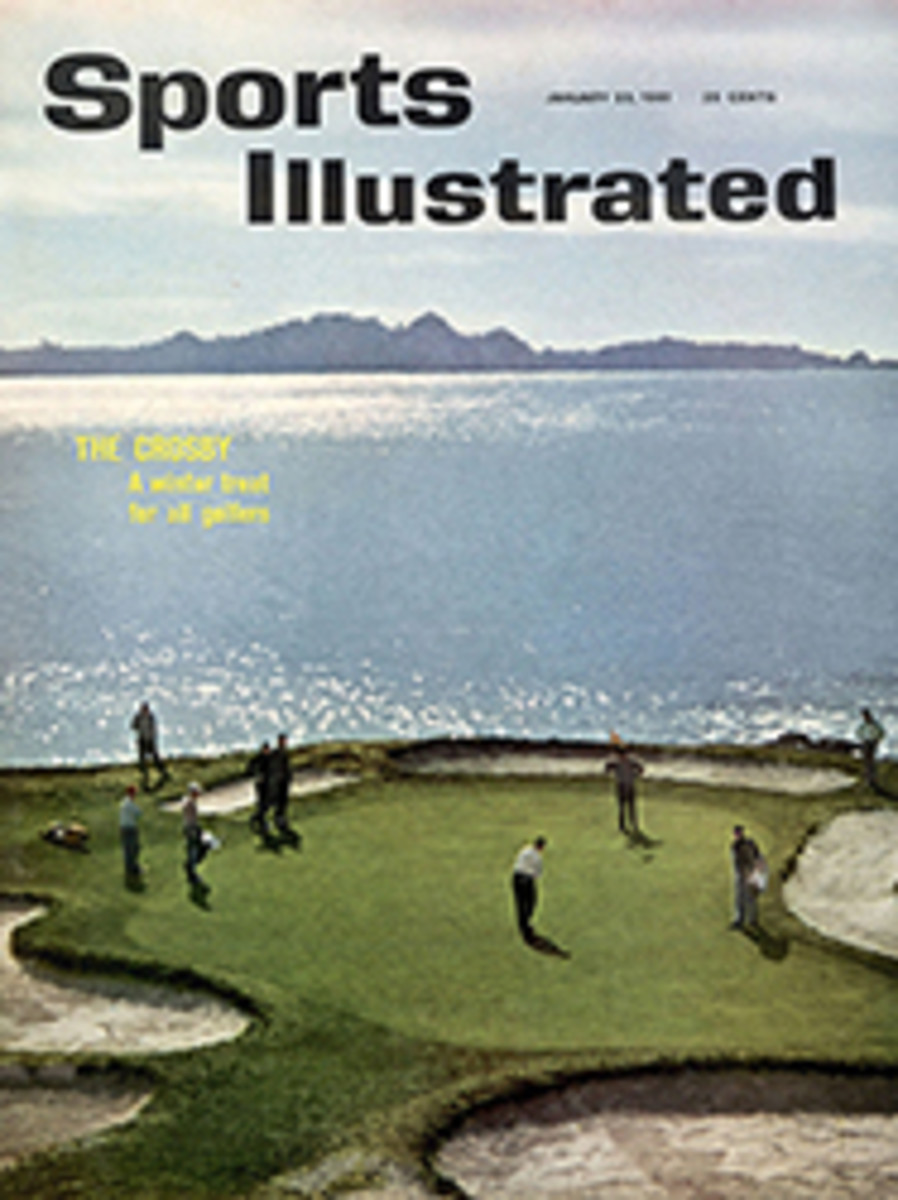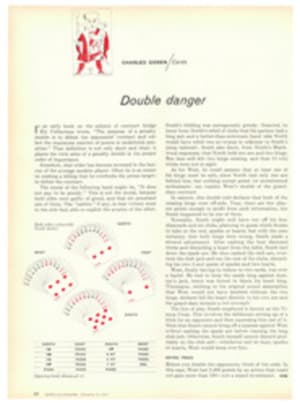
BING AND THE CROSBY
The cold sits heavy in the ground in a great part of the country, but not in California. There the crack of the driver is heard in the land. While businessmen skip out early for an hour or two on the practice tee, the touring pros, most of them still working the kinks out of their winter swings and the hesitations out of their putters, are moving north from the Los Angeles and San Diego opens toward the Monterey Peninsula. So is the rest of the golfing fraternity. For the third weekend of January brings the "Crosby Clambake," or what is now officially called the National Pro-Amateur Golf Championship.
The Crosby, as almost everybody now recognizes, ranks with the Masters in April and the Open in June, each in its own way the most distinguished golfing event on the American sporting calendar. It is played at Pebble Beach, a spectacularly verdant seaside resort about 100 miles south of San Francisco.
Almost always, the Crosby brings with it the year's foulest weather. This was prophetically so when Bing Crosby started the tournament 24 years ago as a two-day pro-amateur golfing party for his friends. At the time Crosby owned a place near Rancho Santa Fe, a bucolic golfing spot between Los Angeles and San Diego. The rain was so bad the first day that roads and bridges were washed out (Richard Arlen, the actor, forded a swollen stream on foot to get there). After a couple of hours there was such a puddle on the first tee that a flock of mallards mistook it for a lake and landed. Eventually Crosby decided to postpone the tournament for the day, and those who could muster shotguns went duck hunting. The next day the sun came out and young Sam Snead became the winner of the first Crosby.
In the years since, the Crosby has grown in stature and importance (in 1958 it went on the air as a nationwide TV show, with Crosby himself as M.C.), but it has never lost the spirit that motivated that first day's play. Hardly anyone is now alive who isn't familiar with the casual friendliness Crosby has managed to pass along to his golf tournament despite the fact that it is now a major four-day sports classic with a total purse of $50,000. Last week as Crosby sat in the living-room of his house in Beverly Hills he reminisced about some of the highlights of previous Crosbys.
"They had a great, great golf course at Rancho Santa Fe when we started," he recalled. "There was a free weekend on the tour then, so I thought it would be fun to get a bunch of pros and some of the top amateurs together for a couple of days of golf. That first time we had 78 pros and 78 amateurs, some of the real good amateurs around here like Johnny Dawson and Roger Kelly.
"There was one time a few years back when it must have rained as hard as you've ever seen it," he went on. "That was the year Jimmy Demaret won, and on this particular day we'd given him an early starting time so he could do a show with me for the Army over at Fort Ord. Jimmy had had a pretty good round under the circumstances, a 75 I think. Well, it went on raining so bad they finally phoned me from Fort Ord and asked if they couldn't call the thing off for the day. Demaret was standing-there with me, and he said, 'What rain? Why, this is a beautiful day. Down in Texas on a day like this we'd be packing our baskets with sandwiches and getting ready for a picnic in the country.' I just didn't have the heart to call the exhibition off."
Many golfers, Ben Hogan included, have picked the 18th hole at Pebble Beach—the one Ken Venturi is driving in the photograph on page 39—as the greatest finishing hole on any golf course in America. It doglegs to the left along the shore of Carmel Bay, and it measures 540 yards. Countless times in the 15 years since Crosby moved his tournament to Pebble Beach a pro-amateur twosome has come to this final hole needing just a par for victory, only to drive both their balls into the water. Playing safely to the right is to risk going out of bounds.
One of Crosby's favorite stories about the 18th concerns the time an amateur named Bill Hoelle drove his second shot onto the rocky beach to the left of the fairway. Hoelle took a four-iron out of his bag and banged his next shot 150 yards or so right off the rocks and over the sea wall, onto the green and into the hole for a 3, giving him a net 2 on the hole with the handicap stroke he was allowed.
"Hoelle was working for Minute Maid, a company in which I had an interest at the time," Crosby said with a chuckle. "I was standing on the green when it happened and announcing the incoming players to a crowd of about 20,000. I was feeling pretty good, because the team I'd bought in the Calcutta was leading the tournament until then. But that shot of Hoelle's won the tournament. As he came up to the green I announced to the crowd, 'The man who just hit that wonderful shot, ladies and gentlemen, was Bill Hoelle, formerly of Minute Maid. From now on he will be selling French fried almonds at Atascadero.' "
For some time now one of the happiest fixtures of the Crosby has been Phil Harris, the former bandleader who is one of Crosby's closest friends. Harris likes to bill himself as playing out of the Jack Daniel's Country Club, but for all his self-deprecating comedy he is a very serviceable 7- or 8-handicap golfer. In 1951 he won the tournament in partnership with Dutch Harrison, thanks to a marvelous 40-foot putt that he sank on the enormous, undulating 17th green at Pebble Beach after Harrison had put his tee shot into the water.
"A few years ago," as Crosby tells it, "Harris was playing with Doug Ford, and it was one of those real windy days. Harris had been all over the course with that big banana ball slice of his. When they came to the 16th Harris had a putt for a 4. Well, you know Ford. He's a man of few words and he likes to play golf quickly. So Harris looks over his putt and then he looks at Ford and asks how he ought to hit it. Ford takes one look and says, 'Just keep it low.' "
In recent years Crosby has had to forego playing in order to ride herd on all the administrative duties he has to supervise during the weekend. But before he quit competing, he almost won the tournament in partnership with Dick Metz. "There's a horrible story connected with that," said the founder with a wince. "Metz and I were right up there in the lead when we reached the 17th green on the last day. Dick's in the bunker, but I'm on the green with a six-footer for a birdie. If I sink it we'll probably win. So I'm standing up to the ball and giving it all this fancy business with my putter and waggling the club back and forth, and the first thing you know I knock the ball backward about three or four feet. That's one stroke, and naturally I miss the putt coming back, so we lose the tournament."
Even though Crosby has given up competing, his personality still saturates the four days of this delightfully soggy event. For the occasion he opens up the spacious modern house he owns on the border of the 13th fairway of the Pebble Beach course. He usually makes a bachelor weekend of it, inviting half a dozen or so of his friends to stay with him there. During the first three days, before the field is cut to the low 60 pro-amateur teams and the low 60 pros, Crosby follows the play on any of the three extraordinarily lovely courses that meander through the pine and cypress forests and across the sandy expanses of the Monterey Peninsula. With the starting field of the Crosby now grown to 300, each team now plays one round at Pebble Beach, one at Cypress Point Club and one at the Monterey Peninsula Country Club. On the last day the final 60 teams finish up at Pebble Beach.
Crosby not only supervises the selection of those who get the precious bids to his tournament but he also tries to chat at least briefly with every one of the golfers he knows personally. In addition, he tapes radio shows, works in a few parties at the houses of friends in the neighborhood and often does a show for the Fort Ord soldiers. On Sunday night following the final round he gives an enormous steak dinner for all the competitors at which he himself awards the $50,000 worth of prizes that go to the pros and the hand-wrought silver pitchers and bowls and plates that go to the winning amateurs. That done, Crosby emcees a show that money couldn't buy. Phil Harris gets the laughs started, Jimmy Demaret sings, Lionel Hebert plays his horn, Don Cherry croons, Bob Hope clowns it up and the host himself delivers the kind of melody that made all this possible in the first place.
Year in and year out the Crosby is most likely the wettest, ruggedest golfing test in the country. But the 50,000 people who turn out to watch, and the more than 4,000 amateurs who always apply for the 150 starting places have learned how to overlook the elements. To them the Crosby is winter's real treat.
PHOTO
JON BRENNEIS
Rain-soaked Ken Venturi drives at Pebble Beach's forbidding 18th
PHOTO
JON BRENNEIS
Wasteland of sand to the right of Cypress Point's 8th fairway adds to miseries of wind and rain for pushed or sliced drive
PHOTO
JON BRENNEIS
Golfer in the trees at Pebble's 16th attracts a sodden crowd
PHOTO
JON BRENNEIS
A casual Crosby stands at the 18th of Pebble Beach as Jimmy Demaret lines up putt.

